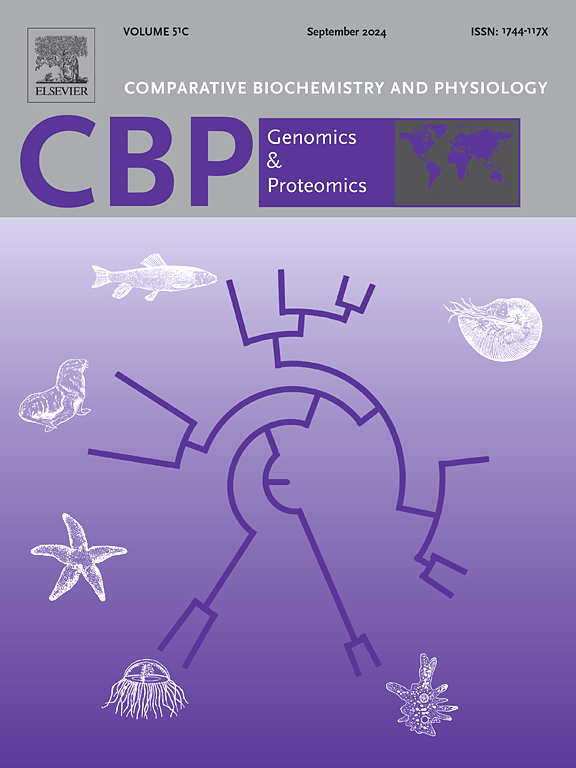Intestinal mucosal transcriptomic responses of Asian seabass (Lates calcarifer) vaccinated with an oral hydrogel-encapsulated multivalent Vibrio antigen following Vibrio spp. infection
IF 2.2
2区 生物学
Q4 BIOCHEMISTRY & MOLECULAR BIOLOGY
Comparative Biochemistry and Physiology D-Genomics & Proteomics
Pub Date : 2025-04-14
DOI:10.1016/j.cbd.2025.101512
引用次数: 0
Abstract
This study examined the intestinal mucosal immune responses elicited by an oral hydrogel-encapsulated multivalent Vibrio vaccine in Asian seabass (Lates calcarifer) to protect against vibriosis caused by Vibrio harveyi, V. vulnificus, and Photobacterium damselae (formerly Vibrio damsela). Both 7-day and 14-day oral vaccination regimens effectively enhanced innate and adaptive immune responses while supporting gut recovery post-infection. Transcriptomic analyses of intestines from fish that received consecutive 7- and 14-day vaccination regimens, followed by co-infection with multistrain Vibrio spp., revealed significant upregulation of innate and specific immune markers at week 8 post-vaccination. These responses were further bolstered by a strong adaptive immune activation, characterized by T-cell and B-cell receptor signaling as well as antibody production. In addition, the vaccine also demonstrated cross-protective immunomodulatory effects, evidenced by elevated interferon-related pathways (e.g., IFNAR2 and IFN-induced proteins), suggesting its potential to protect against co-infecting pathogens, a critical advantage in aquaculture systems facing diverse pathogen pressures. Beyond immune activation, the involvement proteins of TGF-β family members, including BMP3 and BMP4, highlights the vaccine's role in tissue repair and remodeling. These responses likely mitigate epithelial damage and preserve gut barrier integrity post-infection, showcasing the dual benefits of immunoprotection and post-infection recovery. The findings highlight the oral hydrogel-encapsulated multivalent Vibrio vaccine's ability to enhance immunity against specific bacterial pathogens while offering broader immunomodulatory and tissue-repair benefits. Its cross-protective and recovery-supporting properties make it a promising solution for sustainable aquaculture practices, effectively addressing pathogen control and boosting host resilience.

亚洲鲈鱼(Lates calcarifer)感染弧菌后接种口服水凝胶包裹的多价弧菌抗原的肠粘膜转录组反应
本研究检测了口服水凝胶包封的多价弧菌疫苗在亚洲海鲈(Lates calcarifer)中引起的肠道黏膜免疫反应,以预防由哈威弧菌、创伤弧菌和少女弧菌(以前的少女弧菌)引起的弧菌病。7天和14天的口服疫苗接种方案都能有效增强先天和适应性免疫反应,同时支持感染后肠道恢复。对连续接种7天和14天疫苗并同时感染多株弧菌的鱼的肠道进行转录组学分析显示,在接种疫苗后第8周,先天和特异性免疫标志物显著上调。这些反应进一步得到强烈的适应性免疫激活的支持,以t细胞和b细胞受体信号传导以及抗体产生为特征。此外,该疫苗还显示出交叉保护性免疫调节作用,干扰素相关途径(如IFNAR2和ifn诱导的蛋白)的升高证明了这一点,这表明它具有防止病原体共感染的潜力,这在面临多种病原体压力的水产养殖系统中是一个关键优势。除了免疫激活外,TGF-β家族成员的参与蛋白,包括BMP3和BMP4,强调了疫苗在组织修复和重塑中的作用。这些反应可能减轻了上皮损伤并保持了感染后肠道屏障的完整性,显示了免疫保护和感染后恢复的双重益处。这些发现强调了口服水凝胶包封的多价弧菌疫苗能够增强对特定细菌病原体的免疫力,同时提供更广泛的免疫调节和组织修复益处。其交叉保护和支持恢复的特性使其成为可持续水产养殖实践的一个有希望的解决方案,有效地解决病原体控制和增强宿主的抵御能力。
本文章由计算机程序翻译,如有差异,请以英文原文为准。
求助全文
约1分钟内获得全文
求助全文
来源期刊
CiteScore
5.10
自引率
3.30%
发文量
69
审稿时长
33 days
期刊介绍:
Comparative Biochemistry & Physiology (CBP) publishes papers in comparative, environmental and evolutionary physiology.
Part D: Genomics and Proteomics (CBPD), focuses on “omics” approaches to physiology, including comparative and functional genomics, metagenomics, transcriptomics, proteomics, metabolomics, and lipidomics. Most studies employ “omics” and/or system biology to test specific hypotheses about molecular and biochemical mechanisms underlying physiological responses to the environment. We encourage papers that address fundamental questions in comparative physiology and biochemistry rather than studies with a focus that is purely technical, methodological or descriptive in nature.

 求助内容:
求助内容: 应助结果提醒方式:
应助结果提醒方式:


